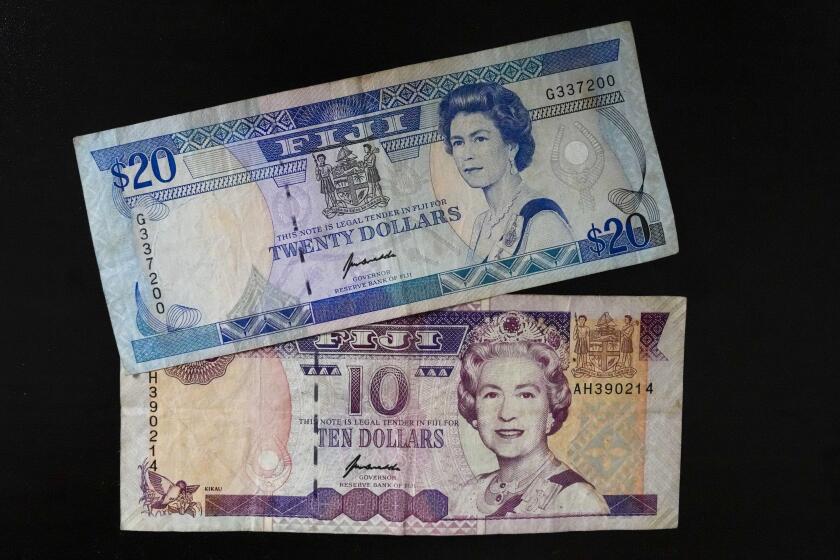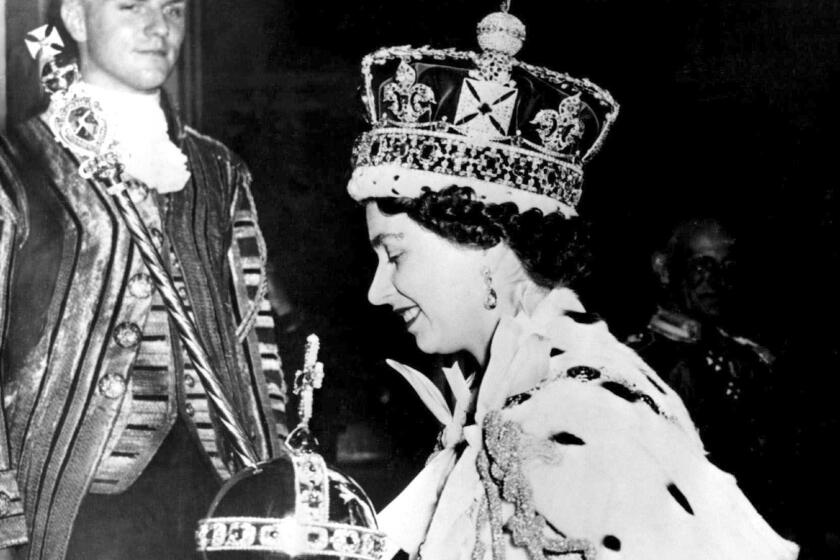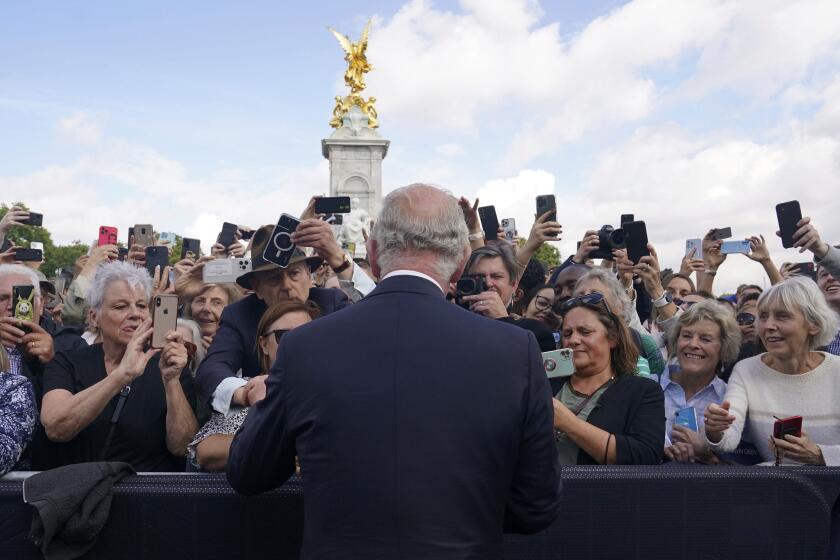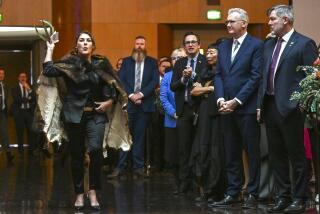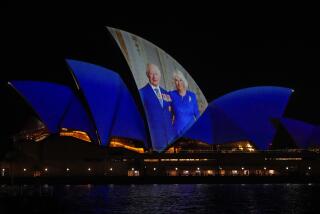Queen Elizabeth II’s coffin takes long road through Scotland
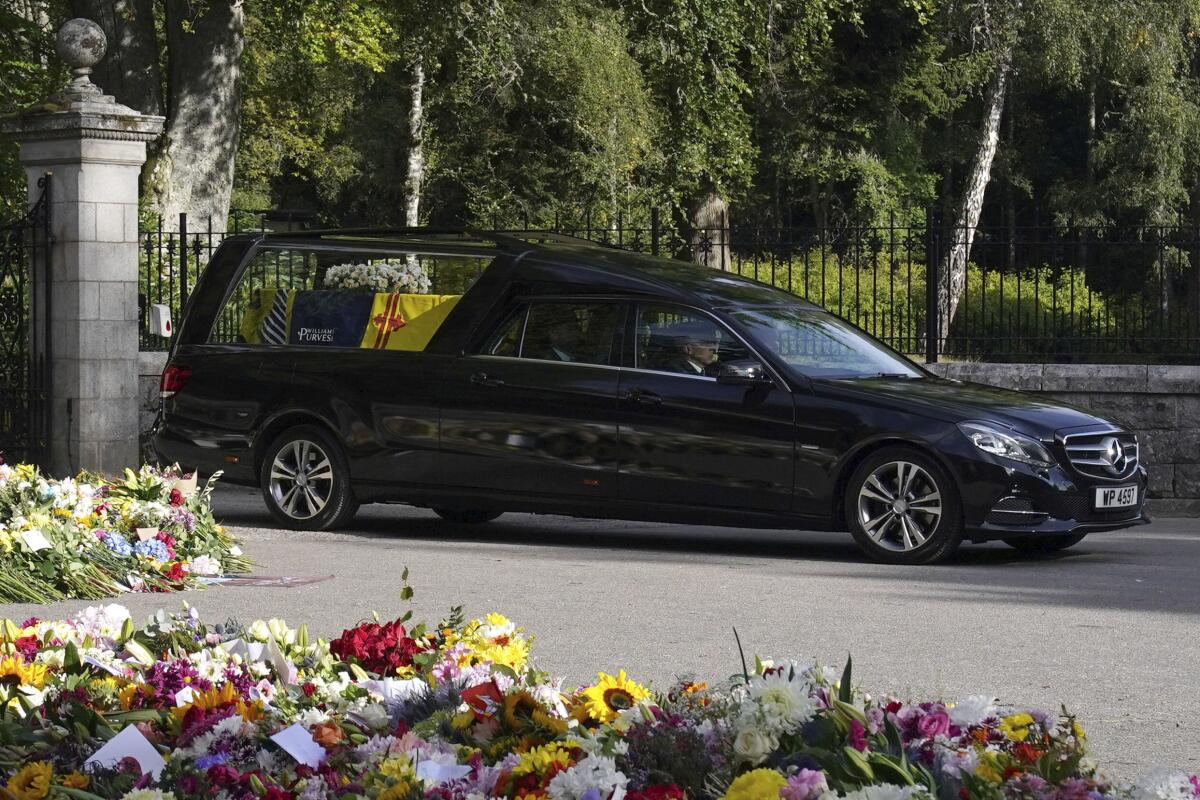
- Share via
LONDON — In a slow, somber and regal procession, Queen Elizabeth II’s flag-draped coffin was driven through the Scottish countryside Sunday from her beloved Balmoral Castle to the Scottish capital of Edinburgh. Mourners packed city streets and highway bridges or lined rural roads with cars and tractors to take part in a historic goodbye to the monarch who reigned for 70 years.
The hearse drove past piles of bouquets and other tributes as it led a seven-car cortege from Balmoral, where the queen died Thursday at age 96, for a six-hour trip through Scottish towns to Holyroodhouse palace in Edinburgh. The late queen’s coffin was draped in the Royal Standard for Scotland and topped with a wreath made of flowers from the estate, including sweet peas, one of the queen’s favorites.
The procession was a huge event for Scotland as the U.K. takes days to mourn its longest-reigning monarch, the only one most Britons have ever known. Hours before the coffin’s arrival in Edinburgh, the Scottish capital, people turned out early to grab a space by police barricades. By afternoon, crowds were 10 people deep in places, eager to be part of the occasion.
“I think she has been an ever-constant in my life. She was the queen I was born under, and she has always been there,” said Angus Ruthven, a 54-year-old civil servant from Edinburgh as he awaited the arrival of the coffin.
“I think it is going to take a lot of adjusting that she is not here. It is quite a sudden thing. We knew she was getting frailer, but it will be a good reign for King Charles,” he predicted.
The first village the cortege passed through was Ballater, where residents regard the royal family as neighbors. Hundreds of people watched in silence and some threw flowers in front of the hearse as it passed.
“She meant such a lot to people in this area. People were crying, it was amazing to see,” said Victoria Pacheco, a guest house manager.
Queen Elizabeth II has been depicted on British banknotes and coins for decades.
In each Scottish town and village the entourage drove through, they were met with muted scenes of respect. People stood mostly in silence; some clapped politely, others pointed their phone cameras at the passing cars. In Aberdeenshire, farmers lined the route with an honor guard of dozens of tractors.
Before reaching the Scottish capital, the cortege traveled down what is effectively a royal memory lane — passing through locations laden with House of Windsor history. Those included Dyce, where in 1975 the queen formally opened the U.K.’s first North Sea oil pipeline, and Fife, near St. Andrews University, where her grandson Prince William, now the Prince of Wales, studied and met his future wife, Catherine.
Sunday’s solemn drive came as the queen’s eldest son was formally proclaimed the new monarch — King Charles III — in the rest of the nations of the United Kingdom: Scotland, Wales and Northern Ireland. It came a day after a pomp-filled accession ceremony in England for that king that was steeped in ancient tradition and political symbolism.
“I am deeply aware of this great inheritance and of the duties and heavy responsibilities of sovereignty, which have now passed to me,” Charles said Saturday.
Just before the proclamation was read Sunday in Edinburgh, a protester appeared with a sign condemning imperialism and urging leaders to “abolish the monarchy.” She was taken away soon afterward by police. Reaction to the protest was mixed. One man shouted, “Let her go! It’s free speech!” while others shouted: “Have some respect!”
Still, there was also some booing in Edinburgh when Joseph Morrow, Lord Lyon King of Arms, finished his proclamation with the words “God save the king!”
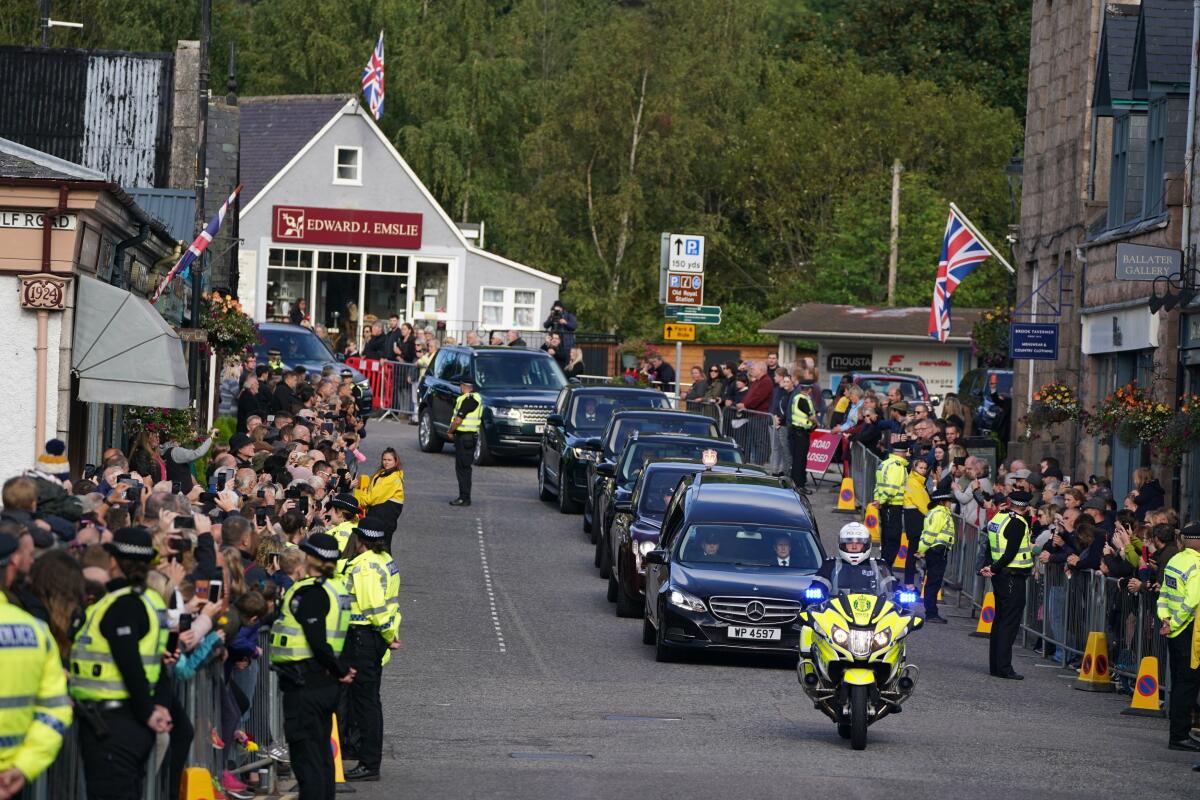
Ann Hamilton, 48, said she thought it was “absolutely terrible” that people booed the royal family during the proclamation of King Charles III in Edinburgh.
“There’s tens of thousands of people here today to show their respect. For them to be here, heckling through things, I think it was terrible. If they were so against it, they shouldn’t have come,” she said.
Still, it was a sign of how some, including Britain’s former colonies, are struggling with the legacy of the monarchy. Earlier, proclamations were read in other parts of the Commonwealth, including Australia and New Zealand.
Charles, even as he mourned his late mother, was getting to work at Buckingham Palace, meeting with the secretary-general and other representatives of the Commonwealth. Many in those nations are grappling with affection for the queen and lingering bitterness over their colonial legacies, which ranged from outright slavery to corporal punishment in African schools to looted artifacts held in British cultural institutions.
Australian Prime Minister Anthony Albanese, who had started laying the groundwork for an Australian republic after an election in May, said Sunday that now was the time not for a change but for paying tribute to the late queen.
For 70 years, Queen Elizabeth II miraculously managed to be both universally known and utterly enigmatic. No wonder so many Americans were fascinated.
India, a former British colony, observed a day of state mourning, with flags lowered to half-staff on all government buildings throughout the country.
Amid the grief enveloping the House of Windsor, there were hints of a possible family reconciliation. Prince William and his brother Harry, together with their respective wives, Catherine, Princess of Wales, and Meghan, Duchess of Sussex, delighted mourners near Windsor Castle with a surprise joint appearance Saturday.
The queen’s coffin was taking a circuitous journey back to the capital. On Monday, it will be taken from Holyroodhouse to nearby St. Giles’ Cathedral in Edinburgh, where it will remain until Tuesday, when it will be flown to London. The coffin will be moved from Buckingham Palace on Wednesday to the Houses of Parliament to lie in state until a state funeral at Westminster Abbey on Sept. 19.
In Ballater, the Rev. David Barr said locals consider the royals as “neighbors” and try to treat them as locals when they spend summers in the Scottish Highlands.
“When she comes up here, and she goes through those gates, I believe the royal part of her stays mostly outside,” he said. “And as she goes in, she was able to be a wife, a loving wife, a loving mum, a loving gran and then later on a loving great-gran — and aunty — and be normal.”
Elizabeth Taylor, from Aberdeen, had tears in her eyes after the hearse carrying the queen’s coffin passed through Ballater.
“It was very emotional. It was respectful and showed what they think of the queen,” she said. “She certainly gave service to this country, even up until a few days before her death.”
Royal mourning will temporarily turn attention away from Britain’s many pressing problems and how a new prime minister will tackle them. Then what?
More to Read
Sign up for Essential California
The most important California stories and recommendations in your inbox every morning.
You may occasionally receive promotional content from the Los Angeles Times.
